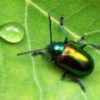Ok, so we all know this is a wasp. But what's with the lumps near the tip of the abdomen?
Ten points for identifying the lump, and five points for anyone ambitious enough to put a name on the wasp, too.
More like this
Seafood science is indeed a pet obsession.
Dear Reader, do you come across a lot of ancient blubber concrete in the course of a normal day? I got some exciting news from Mattias Pettersson Tuesday morning regarding his and Roger Wikell's Mesolithic sites in the Tyresta nature reserve.
The 'scandal' of the kilogram (Blog) - physicsworld.com
Before we get into the regular bloggy shenanigans this week, I would like to share some personal news. Those of you who have been regular readers have certainly read about my family's dog, Argo.


Strepsiptera on a crabrioninae? Just a quick guess.
I too think they are Streps.
Nuts they beat me to it, I too think streps.
Female strep.
Late to the party again. I agree with female stylopid, but I think the wasp is a true sphecid - maybe Isodontia?
Looks like Isodontia mexicana!
But what about those lumps...?
Maybe the bumps are the eggs of another species and the wasp has been parasitized?
Let's try again:
Sphecid: Isodontia auripes
Strepsiptera: Paraxenos auripedis
man, what a picture...
According to my sources, Josh King is close, but auripes should have yellow legs, so Isodontia mexicana seems like a better guess.
No streps listed for mexicana, but it looks like a male pupa.
The lumps have to be strepsiptera, that's about all I know though
Hi guys,
It is a pupal strespipteran and it is a male. The female has an extruded cephalothorax which is dorso-ventrally compressed and very diffciult to see. Requires a hand lens mostly.
The pupa of the male has a line of weakness so when ready the top breaks off and the male emerges for his short (5 hour) non-feeding live. The male mates with the female through the head and sperm goes into her body to fertilise her egss (no ovaries). And the best part...the live young (1st instars) emerge from the females head.
Females never leave their host (they have no antennae, mouth, gut, segmentation or ovaries)